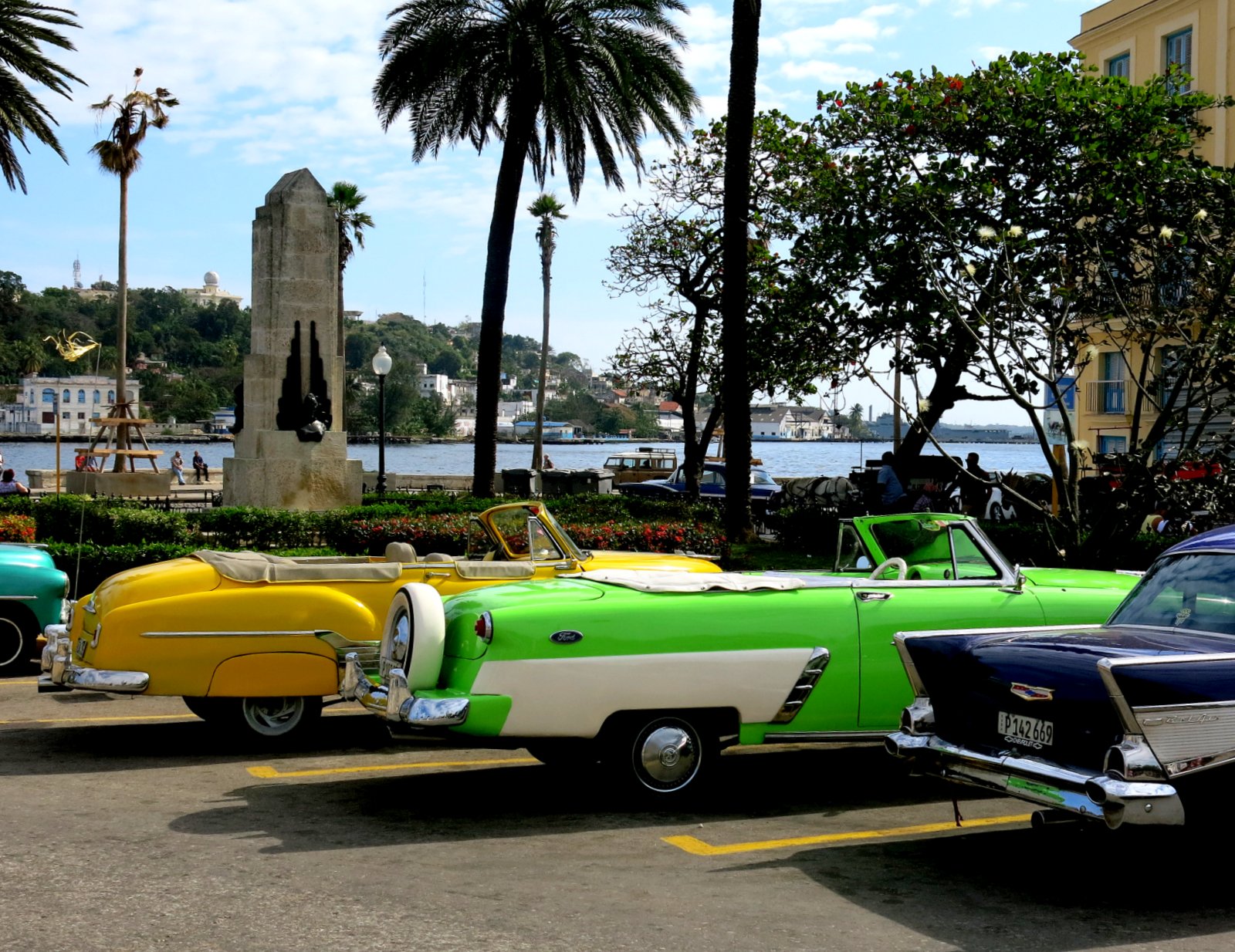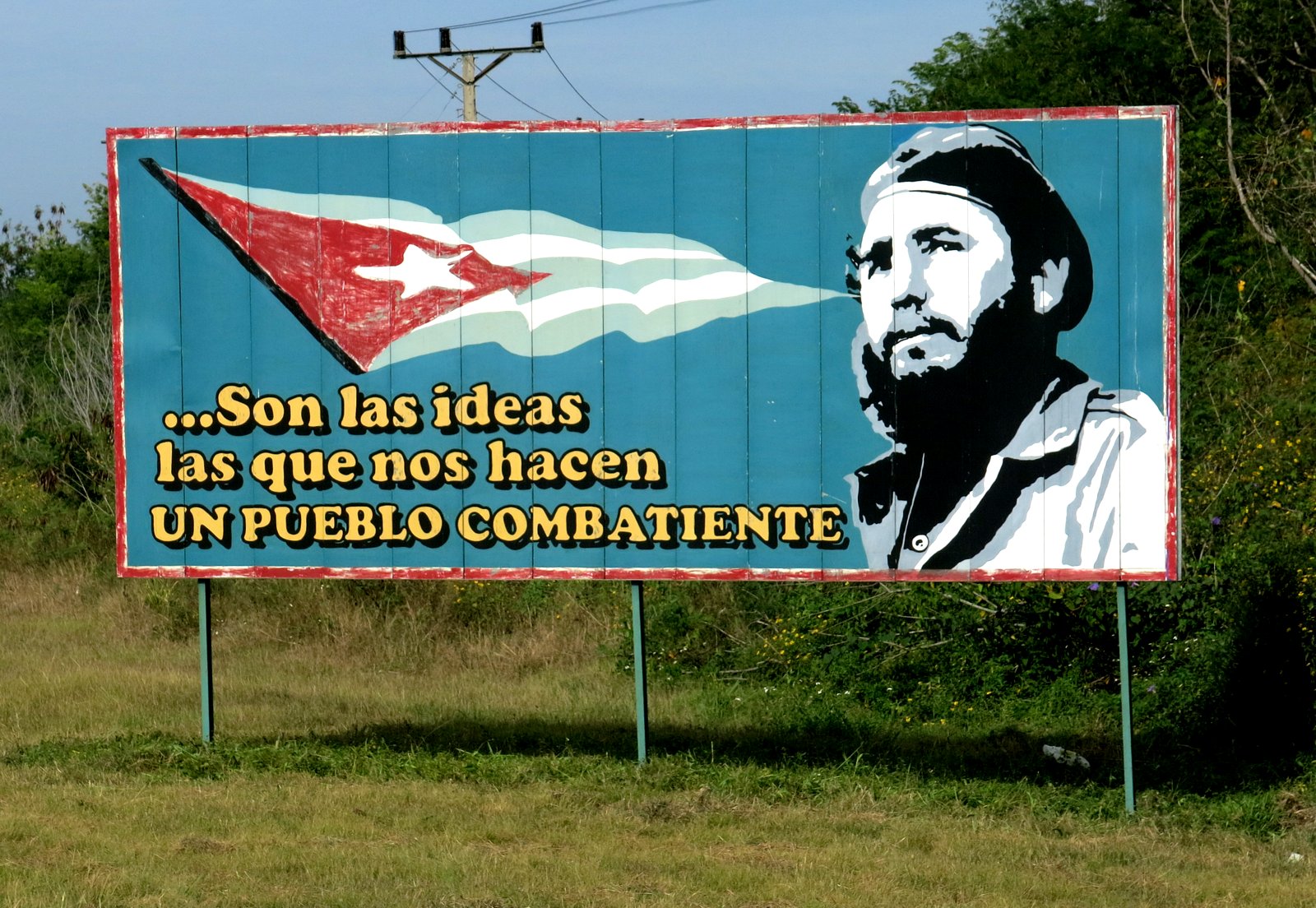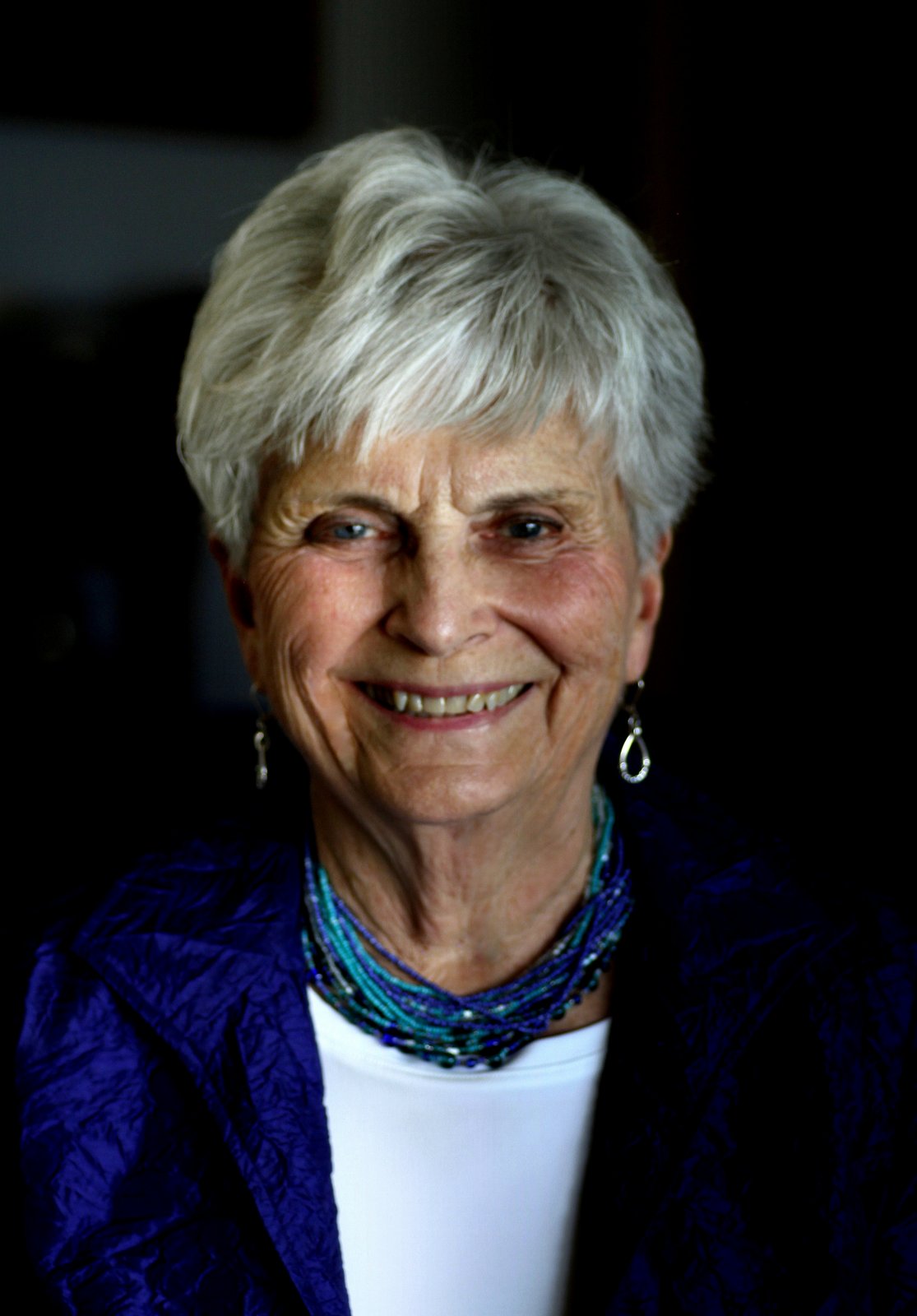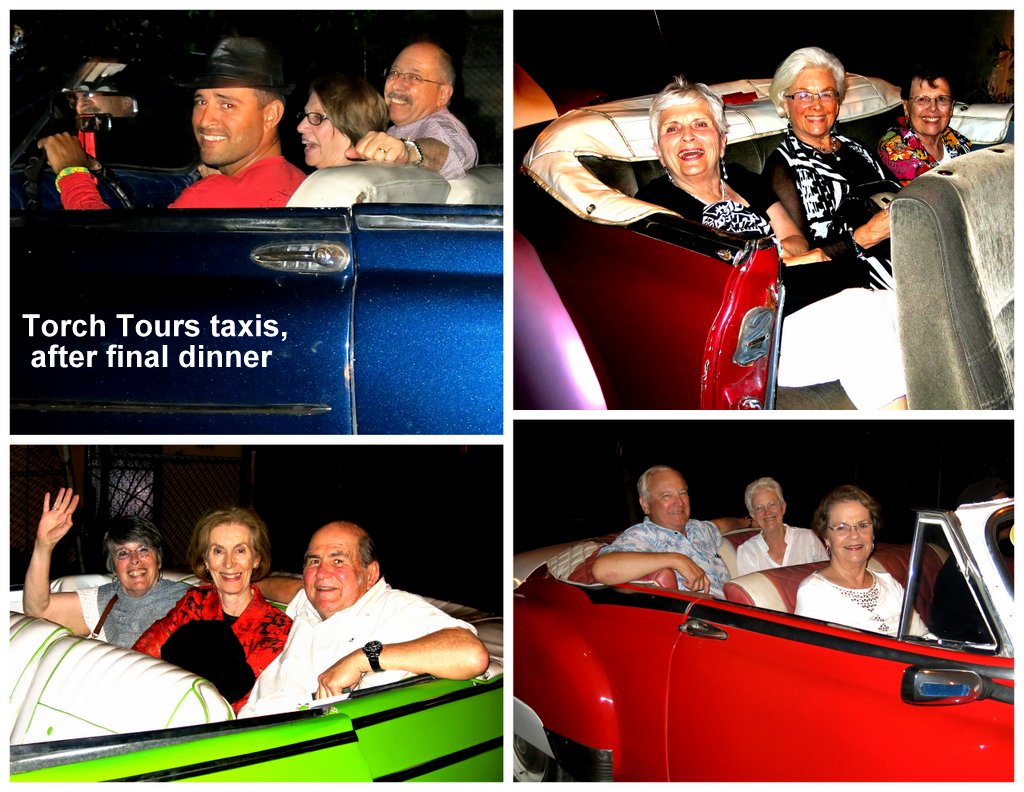

The Torch Magazine, The Journal and Magazine of the
International Association of Torch Clubs
For 91 Years
A Peer-Reviewed
Quality Controlled
Publication
ISSN Print 0040-9440
ISSN Online 2330-9261
Volume 90, Issue 3
|
Cuba's
50-Plus Year Marriage with
Communism: For Better or For
Worse?
by
Anne Thomas
The famous classic cars of Cuba
are an example in microcosm of how
yesterday and today interact in
Cuba's Communist regime. They are
everywhere. In 1959 the Communists
under Fidel Castro, along with
Raul Castro and Che Guevara,
succeeded in deposing the brutal
dictator Fulgencio Batista. At
that time Cubans owned vintage
1950s American cars, tail fins and
all. But the new regime
nationalized all private property,
and all U.S. property, without
compensation, including the cars
and the buying or selling of them.
However, even though the cars were
now property of the state, they
were allowed to remain with their
previous owners. Then, in
1960, the U.S. imposed the trade
embargo, which cut off all trade
between the U.S. and Cuba. With
the embargo it was no longer
possible to import new cars from
the U.S., or anything else for
that matter, and the Cubans were
stuck with driving what they had.
The cars began to deteriorate, but the resourceful Cubans figured out how to maintain them, and a new cult was born. Today, tens of thousands of American cars have been restored, mostly through clever Cuban engineers and black market parts and paint—for example, Japanese parts in an old Ford. They are once again privately owned, an active example of private enterprise. Many are taxis or for private hire. The American cars have become status symbols of prosperity and are highly coveted, but the government still forbids the import of any American cars, and the U.S. trade embargo is still in effect. 
In order to understand the
complicated history of Cuba and
its relationship to the rest of
the world, it is vital to grasp a
few key dates ("Cuba
Timeline").
In 1492, Columbus "discovered Cuba" and claimed it for Spain, which ruled Cuba for the next 400 years. Slavery was not abolished until 1886. In 1898, Jose Marti, writer and revolutionary, Cuba's great national hero, was killed fighting the Spanish; today statues of Marti are everywhere, including Miami. In 1902, Cuba won freedom from Spain, but became a protectorate of the U.S. American support was one of the props of the violent, corrupt Batista, who ruled from 1933 to 1959, the year of the Communist Revolution led by Fidel Castro, his brother Raul, and Che Guevara. In 1960, Cuba nationalized U.S. assets without compensation, leading to the first U.S. trade embargo. The U.S. severed all diplomatic ties and closed its embassy in January 1961, maintaining an Interests Section in Havana and the naval base in Guantanamo Bay April 1961: the Bay of Pigs (Playa Giron)—an invasion of Cuba by 1,400 Cuban exiles sponsored by the U.S. failed. Cuba turned to the Soviet Union. In January 1962, the U.S. expanded the trade embargo, and October of that year witnessed the still vividly recalled Missile Crisis. Cuba contributed militarily to the international communist cause throughout the 1970s, notably in Angola in 1975. 1980 saw the Mariel Boatlift, with more than a hundred thousand Cuban refugees arriving in Florida in the midst of a U.S. presidential campaign. In 1991, the Soviet Union collapsed and withdrew its support for Cuba; very hard times ensued. Fidel called it a "special period." Recovery was slow. In 2006, Raul became dictator after Fidel resigned, and a gradual easing of restrictions began. In 2015, Obama opened the U.S. Embassy and restored diplomatic relations. The President and First Family visited Cuba in March of 2016. In his public speeches, he addressed the complicated history of Cuban-U.S. relations, reminding us that he was the first U.S. President to come without a battleship. Cuba under
Communism, 1959-2016: For
Better?
When we take into account the
brutal regime of Batista that the
Communist Revolution overthrew, it
is not hard to understand the
loyalty of the Cuban people to its
revolutionary leaders. Cuba was
living under a corrupt government
supported in part by the U.S.
government and the Mafia, the
majority of its people suffering
extreme poverty while the wealthy
lived in luxury. Many of the
mansions and fancy hotels are
still standing and are now under
restoration; they give a glimpse
of the past glories of the rich.
When the Communists took over,
they immediately made changes. In
typical Marxist fashion, they
nationalized all private property,
including housing (no one was
evicted from their home, but the
government now owned it), those
cars, the large sugar cane fields
owned by U.S. companies such as
United Fruit, American-owned Cuban
oil refineries, and all means of
production (United Fruit
Historical Society).
Another big move was the establishment of free education for all, kindergarten through university. Education prospered, and students were sent out in droves to the countryside to teach reading and writing to the local farmers, following the Communist Chinese model instituted by Chairman Mao in the early 1950s. Today Cuba's literacy rate is equal to the U.S. and higher than most Latin American countries (World Factbook). Education at all levels is government sponsored. There are many schools for special talents such as athletics, science, art, and music. Cuba is especially known for its music; its musicians perform worldwide. Cuban athletes have achieved stardom in the Olympics and in American major league baseball. Many of Cuba's most famous players defected to the U.S. in the past, and today are not allowed to play in Cuba. However, one of their most famous sluggers, first baseman Antonio Munoz, never defected to the U.S. and remained in Cuba all his life. He now runs a baseball camp for young boys. Along with universal education came universal medical care. The government set out to build and equip medical schools, and this effort was eventually so successful that Cuba came to enjoy a surplus of doctors; many left to set up practice and spread the socialist doctrine in other Communist countries and in Latin America ("Cuba's Medical Diplomacy"). Students were even coming from abroad to train at Cuban medical schools. According to UNICEF, the Cuban life expectancy is 79.1 years, close to that of the United States. There are indications, however, that today the Cuban medical system may be breaking down. It is difficult to get statistics on this, but according to eyewitness accounts, regular medical care and hospitals are malfunctioning and facing a serious shortage of supplies and doctors (Sabatini). Now the government is making it difficult for Cuban doctors to leave Cuba, and the government places heavy restrictions on their exit visas. This is contrary to the new policy of easing travel restrictions. Another area of huge change was the status of women. Women gained equal rights under the revolution thanks to their new literacy, educational opportunities, and government-supported health care, family planning, contraception, and abortion. Women hold 70% of the professional careers today, and there is no wage gap, our Torch tour group was told; equal pay for equal work is the norm. When Raul Castro gave his speech in Havana during President Obama's visit, he bragged that American women cannot claim equal pay, but that Cuban women can. A more cynical view is to say they share the low wages with the men. The Cuban birth rate has dropped to 9.5/1,000, below replacement level (U.S. is 12.5), and population has tanked. This is a worry for Cuba as it is for other countries whose birth rate has fallen. Who will take care of the elderly? One theory to explain the low birth rate is the extreme pessimism of couples of childbearing age about their own economic future. And, as in the United States, marriage rates are down. There are no obvious homeless people, an apparent outcome of the new regime's takeover of all housing. (There are oodles of stray dogs but no stray people—in the U.S. the reverse is true). Everyone has a place to live provided by the government, and no one is evicted. This does not always lead to a pleasant environment, and the non-owners often do not take care of their places. One of our guide/lecturers was asked, "When the roof is leaking, who is supposed to fix it?" His answer: "Relax. You're in Cuba." We did see overcrowding in many apartment buildings, and from all reports in the American press there are large urban renewal projects that are run down. The Communist government claims that extreme poverty is eliminated, at least for the time being. Salaries are all equal—a doctor and a farmer earn the same. However, the evidence shows that salaries are on the rise for the highly educated. Cuba
under Communism, 1959-2016:
For Worse?
The victory for Fidel and the
Communist regime in 1959 led to a
foreign policy disaster. It was
the height of the Cold War, and
the U.S. was very fearful of
Communism and the Soviet
Union. The revolution led
not only to the trade embargo and
the breaking of diplomatic
relations, but also to a huge wave
of migration of wealthy, educated,
professional Cubans to the U.S.
and elsewhere—a serious brain
drain. The Cuban government
then closed the exit doors.
This was the context in which the ill-fated Bay of Pigs invasion occurred. Directed by the CIA and sponsored by the U.S. military, and following a plan approved by President Eisenhower, an army of 1,400 poorly trained and equipped Cuban exiles invaded from the U.S. by way of Guatemala in April 1961. At the last minute, President Kennedy called off American air power. The invasion was quickly defeated. The Cuban exiles were mostly imprisoned, and a few executed. 1,113 prisoners were later exchanged for goods and food from the U.S. and exiled back to the U.S. The Cubans suffered an estimated total of 500-4,000 casualties. The Bay of Pigs invasion led Cuba to turn further towards the Soviet Union and directly contributed to the Cuban Missile Crisis of 1962 ("Bay of Pigs Invasion"). With Fidel Castro's enthusiastic blessing, the Soviet Union, then under Nikita Khrushchev, secretly established nuclear missile bases in Cuba. Once they were discovered and made public, the world was in crisis, and in the midst of the crisis Castro urged the Soviets to use the missiles (Nay 31-32). The crisis finally ended when the U.S. agreed to withdraw its missiles from Turkey in exchange for removal of the Soviet missile sites ("Cuban Missile Crisis"). The Cold War was at its height, and Cuba moved completely under the domination of the Soviet Union. Freedom of speech was closed down and to a great extent remains so. Our tour group saw no newspapers on the streets, although our guide gave us some from his grandmother's cache. They were all propaganda. As the internet and cell phones emerged elsewhere in the world, the Cuban government forbade their use. Today there is some usage, but it is very expensive. TV is available, but is also very expensive. Propaganda posters and billboards of Fidel, Che, Raul, Jose Marti, and Hugo Chavez, the Venezuelan dictator, are very common. Amnesty International and Human Rights Watch report thousands of dissidents jailed over the years. Seventy-five Cuban men who had spoken out against the government were jailed in the "Black Spring" of 2003. Two weeks later, their wives, mothers, sisters, and sweethearts gathered for mass in St. Rita's Catholic church in Havana with the blessing of the Bishop and the Catholic Church. Following the mass, dressed in white, they paraded quietly through the streets. They are still in action and are known as the "Damas de Blanco" or "Women in White" (TVAANATECH Tolerance Project; "Ladies in White"). They have been harassed, jailed, taken far out of town on buses and left there, but they still continue. In 2011 the last dissidents from the original seventy-five were released, but the women in white still march on. In March 2016, they led their usual walk after mass the Sunday before Obama arrived. They were again harassed by Cuban police, loaded onto buses and taken away, all in full view of TV cameras. Political prisoners were freed in a U.S.-Cuba prisoner swap agreement before Obama went to Cuba (O'Malley). However, the evidence seems to show that while there probably are very few long-term political prisoners remaining, many short-term imprisonments continue as a form of harassment. Food shortages began with the communal farm system of the Communist Revolution, and today Cuba imports 70% of its food. The government has loosened restrictions, and now 30% of the farms are privately owned, and these private farms supply 70% of all the food that is produced in Cuba. The communal farms are definitely "for worse." All Cubans have a government ration card, which they take to a ration store to redeem for food staples such as rice, beans, and flour sold at reduced prices. Cubans say, "we love our ration cards." Relax, you're in Cuba. Buildings and infrastructure declined under Communism because of the lack of government funding, and decay set in everywhere. Soviet style urban renewal created ugly government-owned housing development buildings. These projects have become overcrowded slums, not usually visited by tourists. Change in
the Future: For Better or For
Worse?
Following the resignation of Fidel
in 2006, under Raul the government
has loosened restrictions, and the
buying and selling of goods and
houses is happening everywhere.
Private property is now allowed for many parts of society—mobile phones, houses, cars, farms. Small private enterprises around the tourist trade are springing up all over Cuba, such as restaurants called paladares, and bed and breakfasts called casas particulares. Many particulares are listed on Airbnb.com, the online worldwide reservations service. Our Cuban guide had an app on his phone listing paladares and casas particulares, and we had an excellent lunch at a paladar owned and run by a family. Juxtaposed with this small blooming of free enterprise, a public high school located across the street is named for Nguyen Van Troi, a young Vietcong revolutionary executed in 1963 at the height of the Vietnam War for his role in plotting the assassination of Secretary of Defense Robert McNamara in South Vietnam. There are several public buildings in Cuba named for him. Tourism is flourishing, and the Cuban government has invested in a large brand new and up to date fleet of buses made in China. Our bus driver, who had maintained Soviet MIG's for the Cuban military during the Cuban-supported Communist revolution in Angola, was very clear that the Chinese make a better bus engine. Airlines may soon be able to fly freely into and out of Cuba, but right now, to enter from the U.S. a passenger must use a Cuban charter flight. The first cruise ship arrived in Cuba in May 2016, docking in Havana. There are plans for a direct ferry from Florida, either Marathon Key or an adjacent Key. The distance is only 90 miles—one could almost swim, except for the sharks! Hotel chains are vying for permission to restore and reopen hotels, mostly in Havana. There are four main squares in Old Havana, and they feature large restoration projects financed by the government, mostly through tourist dollars. The restoration of the beautiful old Spanish style architecture in Havana is being carefully planned by a well-respected architect. In the weeks before Obama's visit, the government launched a huge painting and general tidy up of Havana. Travel restrictions have opened up, and Cubans may leave and reenter much more easily. Many Cubans travel back to Cuba with enormous suitcases full of goods for their families—or maybe for the black market? This freedom is not extended to the highly educated—doctors, engineers, scientists. They still have to purchase expensive exit visas and are usually denied. Christmas was made a national holiday in 1998 after an almost fifty year prohibition of public displays of Catholic Church activities. Three Popes have visited Cuba, and Pope Francis has come twice. Patriarch Kirill of Moscow, the head of the Russian Orthodox Church, visited Cuba and met with Pope Francis while we were there in February 2016. The Cubans are very concerned about conservation of the environment and fortunately, several huge areas are under government protection. The Zapata Swamp, south and east of Havana, is similar to the Everglades, and is protected. A conservationist gave our group a lecture on the swamp, and said that rangers/scientists visit with their U.S. counterparts in the Everglades. However, as Cuba opens to tourists and tourist dollars, the race to "develop" Cuba's empty spaces is on.  Conclusion:
The Marriage is Still Strong
With the influx of tourist dollars
and the loosening of tight
government controls, the future of
Cuba looks brighter. However, the
succession to Raul Castro and
other old-line Communist leaders
may reverse the progress already
made. There appears to be more
harassment of critics and
dissidents since Obama's visit,
but those U.S. dollars may help to
keep progress continuing.
On our final night we had a delicious dinner at a privately owned paladar and were treated to a performance by a group of women singers, excellent musicians and an example of Cuba at its racially integrated best. They sang in Spanish, of course, but then announced they would sing an American song: "Oh the weather outside is frightful […]. Let it snow, let it snow, let it snow!" –followed by much laughter. Asked if any of them had seen snow, they answered no, so they were invited to visit the U.S. We were then driven back to our hotel in a parade of those wonderful cars and called it a night. Works
Cited and Consulted
"The
Bay of Pigs Invasion and its
Aftermath, April 1961 - October
1962." Office of the Historian, U.S.
Department of State.
history.state.gov. Web.Cuba: Castro, Revolution, and the End of the Embargo. Berkeley, California: Lightning Guides, 2015. "Cuba Timeline: A Chronology of Key Events." BBC News. Web. "Cuba's Medical Diplomacy." aljazeera.com. Web. "Cuban Missile Crisis." History.com. Web. "Ladies in White Protesters Held in Cuban Crackdown." BBC World News. Web. Accessed July 14, 2014. Nay, Sherry. "Cuban Missile Crisis: The Soviet View." The Torch 89:1 (Fall 2015), 29-32. "Nguyen Van Troi." Wikipedia. O'Malley, Nick. "U.S.-Cuba diplomatic breakthrough: Obama and Castro agree to thaw relations after prisoner exchange." Sydney Morning Herald. December 18, 2014. Web. "Religion in Cuba." Wikipedia. Sabatini, Christopher. "Five Myths: Cuba." Washington Post, March 27, 2016. Sainsbury, Brendan, and Waterson, Luke. Cuba. Lonely Planet, 2015. Sweig, Julia E. Cuba: What Everyone Needs to Know. 2nd Edition. NY: Oxford UP, 2012. TVAANATECH Tolerance Project. The Ladies in White Marching for Change in Cuba. E.collaborative for Civic Education, 2016. United Fruit Historical Society. "1959: Fidel Castro begins his agrarian reform and seizes the sugar properties of the United Fruit Co." unitedfruit.org. Web. Vichot, Julio Cubria. A Brief History of Cuba: From Columbus to the 21st Century. Havana: Editorial Capitan San Luis, 2014. World Factbook. "Cuba: People and Society." CIA. cia.gov. Accessed 2016. Author's
Biography
 Anne Thomas is
retired as Director of the
Office of International
Education at Lehigh University
and was previously a senior high
school teacher of world history.
A graduate of Oberlin College with a BA and of Lehigh University with an MA, she was the recipient of two Fulbright Teacher Study Grants to China and India. She is an active docent at the George C. Marshall House in Leesburg, Virginia, where he lived during and after WW II. She is a founding member of the Leesburg Blue Ridge Torch Club and served as its President. Currently she is the IATC Director of Region 3, and was previously a member of the Torch Clubs of Lehigh Valley, PA and Frederick, MD. She has given four papers at Torch, one of which, "George C. Marshall: The Man and the Plan," was published in The Torch. She was one of twenty-two Torch members from ten different clubs who traveled to Cuba on Torch Travel in February 2016. This paper is a result of that fascinating trip. Anne's husband, David, is a past Torch President and the photographer for this paper. The Cuba paper with David's photographs was presented to the Leesburg Blue Ridge Club on April 19, 2016, and will be given to the Frederick Torch Club on April 24, 2017. With thanks for editing to Jackie Meeks, fellow traveler to Cuba and member, Leesburg Blue Ridge Torch. Additional Photos from
Cuba Trip.
 Group Photo Naional Hero Results of Low Birthrate. Similar to most developed countries. A very popular undertaking!! ©2017 by the International
Association of Torch Clubs |